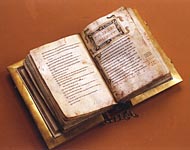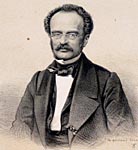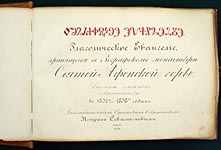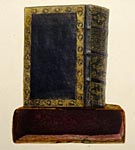About Manuscript
The Codex Zographensis or Tetraevangelium Zographense is a Slavic landmark manuscript, one of the few extant Glagolitic manuscripts. In 11th-12th centuries, the oldest Slavic alphabet - the Glagolitic script developed into the Cyrillic letters. The Codex Zographensis makes it possible to trace the evolution of the Glagolitic script and its transformation into the Cyrillic alphabet.The parchment Codex Zographensis consist of three parts written in different scripts at different times.
The major part of the manuscript was created in the 11th century; its is written in a round Glagolitic script (the oldest type of Glagolitic letters). In the 12th century, several sheets were inserted into the body of the book, apparently, to complete the text lost by the time. These added pages are of great interest becase they are palimpsests.
Palimpsests are parchment manuscripts which sheets have been written upon twice or even three times. The original writing that, for whatever reason, became unnecessary, has been washed off from the parchment sheet (which was very expensive to produce) and replaced with a new text.
So, palimpsests are valuable material for the study of the history of ancient texts, because they bear visible traces of their earlier writing. The lower layer can be read using opto-electronic methods. The Codex Zographensis contains seven palimpsest sheets: the 11th century Glagolitic text of the Four Gospels has been erased.
And finally, the third part of the book (pp. 289-304) was written in Cyrillic in the 13th century. The scribe of this part - Priest John - left his name in the record read on f. 288 v. manuscript. This last part consists of supplements to the Gospels - the book of saints with the church calendar. Judging by the linguistic features of the Cyrillic text, Priest John was Bulgarian.
The margins of the manuscript sheets carry numerous inscriptions and notes made both in Glagolitic and Cyrillic alphabet: all sorts of additions, corrections, explanations of the main text, opening words of the readings, etc. The content of these notes is a special subject of study.
The Codex Zographensis is decorated by characteristic headpieces of geometric ornament and initials. Particularly noteworthy are archaic pictures on some pages of the book. Modern research has led to the conclusion that the original manuscript was decorated with miniatures of the Evangelists. This is evidenced by traces of the paint on the folios which, proceeding from the order of the Gospels, could contacted with the missing sheets with miniatures. However, scientists are still unable to find these miniatures.
The history of the Codex Zographensis is uncertain. According to oral tradition, the manuscript was held in the conventual church of the Bulgarian Zograf monastery near the town of Ierisso on the Athos peninsula, then the book was transferred to the monastery. The landmark was made known to scientists in 1843, after the Croatian writer and collector of manuscripts Antun Mihanović (1796-1862), served as Austrian consul in Constantinople, saw him in the Zograf monastery. Already in the next year, the Zograf Monastery was visited by the a historian and Slavist Viktor Grigorovich (1815-1876), a professor of universities in Kazan, Moscow and Odessa. He commended the Codex Zographensis as the most important manuscripts of those stored at that time on Mount Athos. In 1860, the abbot of the monastery, Archimandrite Anthimus with the brothers donated the Codex to the Russian Emperor Alexander II.
The precious gift was transferred through the archaeologist, traveler and collector Peter Sevastyanov (1811-1867).He was on Mount Athos in 1859, being appointed by the Russian government as the head of a special expedition to gather Christian antiquities. The archaeological collections in Moscow and St. Petersburg were established as a result of the expedition.
Peter Sevastyanov assembled a world renowned collection consisting of copies and photographs of landmarks of ancient art and literature; images of architectural objects; plans; maps; coins.Then the collection was dispersed between the Russian State Library in Moscow, the Academy of Fine Arts in St. Petersburg and the Manuscripts Department of the National Library of Russia (Collection No. 680. Report of the Public Library for 1862. Pp. 18–21).
The latter fund contains a luxurious leather album with photographs of the Codex Zographensis made by Peter Sevastyanov in 1859 in the Zograf Monastery, intended for presentation to the Emperor. In 1861, the Imperial Public Library received the Codex Zographensis together with all the other books presented to Russian Emperors. In Russia, the manuscript was rebound with new covers with a framework which is a real piece of the 19th century applied art. The binding, in which the manuscript arrived in St. Petersburg, you can see on the photograph from the P. Sevastyanov album. Judging by this picture, the binding also was made in the 19th century, probably, especially for the presentation of the manuscript to Alexander II.P. Sevastyanov's photographs show that some manuscript sheets were severely damaged by the fungus. In the 90s of the 20th century, book was restored: the book binding was removed to loose and doctor folios. Today, the manuscript is being kept in the National Library of Russia in the form of unbound sheets apart from the book covers.
There are a large number of reference works on the Codex Zographensis and its publications.
An important contribution to the study of the Codex Zographensis was made by the curator of Slavic and Old Russian holdings of the Manuscripts Department Vyacheslav Zagrebin (1942 - 2004).





